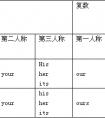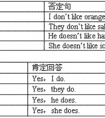用括号内所给单词的适当形式填空。1.Don't forget _______(turn) off the TV when you go to bed.2.That's the _______(end) of the story.3.The mice all ___ (flee-九年级英语
分词可以有自己的状语、宾语或逻辑主语等。
现在分词构成形式:
①一般在动词原形末尾加ing,如do→doing、sing→singing、comfort→comforting
②以不发音的e、ue结尾的动词,先去e,再加ing,如dance→dancing、hike→hiking、write→writing、make→ making,take→taking
③以ee、oe、ye结尾的动词加ing,如see→seeing、toe→toeing、dye→dyeing
④以重读闭音节结尾的动词,并且末尾只有一个辅音字母,应双写这一字母,再加ing,如cut→cutting、swim→swimming
注:结尾是x则不必双写,如relax→relaxing
⑤以ie结尾的动词,要把ie变成y再加ing,如die→dying,lie→lying.
⑥以ic结尾的动词,要把ic变成ick再加ing,如picnic→picnicking,traffic→trafficking
过去分词构成形式:
1.规则动词:规则动词的过去分词的构成规则与规则动词的过去式的构成规则相同。四点变化规则:
(1)、一般动词,在词尾直接加“ ed ”。(然而要注意的是,过去分词并不是过去式)
work---worked---worked , visit---visited---visited
(2)、以不发音的“ e ” 结尾的动词,只在词尾加“ d ”。
live---lived---lived
(3)、以“辅音字母 + y ”结尾的动词,将 "y" 变为 "i" ,再加“ ed ”。
study---studied---studied,cry---cried---cried,try---tried---tried,fry---fried---fried.[1]
(4)、重读闭音节结尾,末尾只有一个辅音字母,先双写该辅音字母,再加“ ed ”。
stop---stopped---stopped , drop---dropped--dropped
(5)、以ic结尾的动词,要把ic变成ick再加ed,
picnic→picnicked ,traffic→trafficked
2 、不规则动词:见不规则动词表
分词用法:
1、分词作状语
分词在句子中作状语,可以表示时间、条件、原因、结果、让步、伴随等。
分词(短语)作状语时,其逻辑主语应与句中主语相一致。
当现在分词表示的动作发 生在谓语动词之前时, 则用现在分词的完成式,且所表示动作与谓语动作同时发生, 则用现在分词的一般式。
完成或被动关系用过去分词。
①现在分词:
The students went out of the classroom, laughing and talking.
②过去分词:
Accompanied by his friend, he went to the railway station.
Given better attention, the plants could grow better.
2、“while ( when, once, until, if , though等连词)+分词”结构
现在分词或过去分词作状语时,有时可以在分词前加while,when, once, although, until, if等连词。
①现在分词:
When leaving the airport, she waved again and again to us.
While waiting for the train, I had a long talk with my sister about her work……
②过去分词:
Once recovered, he threw himself into his work and made every effort to do it well.
Although working very hard, he failed to pass the final exam. If translated word by word, the passage will be difficult to understand.
3、分词作定语
分词作定语时,单个的分词通常放在被修饰的名词之前,分词短语一般置于所修饰的中心词后面。
现在分词修饰的是发出该动作的名词(即与名词有主谓关系),过去分词修饰承受该动作的名词(即与名词是动宾关系)。
We will go on with our experiment as soon as we get the added fund.
This is really an exhausting day to all of us!
We can see the part of the moon lighted by sunlight.
After a night spent in excitement and sleeplessness, I forced myself to take a long walk along the beach the next day.
More and more developing countries established strategic partnership with developed countries
4、分词作宾语补足语
现在分词在see, watch, hear, observe, notice, feel, find, glimpse, glance等感官动词和look at, listen to等短语动词以及
have, keep, get, catch, leave, set, start, send等使役动词后面与名词或代词构成复合宾语,作宾语补语的成分。
例:I see him passing my house every day.
I caught him stealing things in that shop.
I smelt something burning.
5、分词作表语
分词作表语通常看作形容词来用。
过去分词表示主语的感受或状态,主语多为人。现在分词表示主语的性质,而且主语多为物;
①过去分词:
We were so bored that we couldn’t help yawning.
She felt confused, and even frightened.
②现在分词:
He was very amusing.
That book was rather boring.
很多动词的现在分词都可以作表语:
exciting, interesting, encouraging, disappointing, confusing, touching, puzzling.
考点名称:现在进行时
- 现在进行时:
表示现在或当前一段时间正在进行的动作。可以表示有计划的未来,也就是用现在进行时表示将来。
现在进行时的构成是:
主语+be+v.ing〔现在分词〕形式
例如:He is writing on the desk. 现在进行时的构成:
主语+be+v.ing〔现在分词〕形式
第一人称单数I+am+ing.
第一人称复数We+are+ing.
第二人称单(复)数 You+are+ing
第三人称单数 He(She,it)+is+ing
第三人称复数 They+are+ing
肯定句:主语+be(is/am/are)+现在分词
否定句:主语+be(is/am/are)+not+现在分词
一般疑问句:be(is/am/are)+主语+现在分词
特殊疑问句:特殊疑问词+相应be动词+主语+现在分词+Sth?
间接引语中改为过去进行时。
变化规则:
1.直接+ ing(例:sleep+ing 变sleeping)
2.去掉不发音的e+ing(例:bite-e+ing 变biting)
3.重读闭音节,以辅音字母加元音字母加辅音字母结尾的词,要双写尾字母再加ing(例:swim+m+ing=swimming)
4.以ie结尾的重读闭音节,变ie为y+ing (例:die-dying lie-lying)
5结尾为c且c读作/k/时,在结尾加k再加ing,如picnic-picnicking现在进行时与一般现在时的区别:
(一)现在进行时表示动作的暂时性,而一般现在时表示动作的习惯性和经常性
I am watching TV now. (暂时性)
I watch TV every day. (经常性)
(二)现在进行时可表示短暂性动作,而一般现在时表示长久性动作。
Lucy is living in Beijing.(短时间居住)
Lucy lives in Beijing. (长久性居住)
(三)现在进行时表示的动作可带有感情色彩,而一般现在时所表述的动作通常是事实。
You’re always forgetting the most important things. (责备)
He is always helping others. (赞扬)
He often helps others. (事实)
(四)有些动词不能用进行时,know, understand, love, like, hate, wish, want, think, hope, have, believe, agree, hear, see, notice,等等。
这些动词通常用一般现在时表示说话时发生的动作。
I have a lot of friends here.
She wants to buy a new bike.
现在进行时用法注意:
1.进行时中,并不是所有的动词都要使用正在进行时。
例如一些表示状态和感觉的动词,一般不用进行时态,而是用现在一般时表示。
这些动词往往是等表示情感状态、知觉认识、愿望或短暂性的动词。
例如:see(明白),know, want, like, hear, have(有), think, hope, hate等。
I hear someone singing. 我正听见有人唱歌。
Do you see anyone over there? 你看到那里有什么人吗?
What does he think of it? 他觉得这怎么样?
如果这些词使用正在进行时态,句子带有某种感情色彩。例如:
Are you seeing someone off? 你在给谁送行吗?
They are hearing an English talk. 他们在听一个英语报告。
2.现在进行时还有另外一种含义,即它们能表达即将发生的事情,相当于一般将来时。
有些动词从结构来看是现在进行时,但却是表示将要发生的事,而不表示动作现在正在进行。
这些动词往往是一些表示位置移动变化的动词:arrive, come, do, get, go, have, leave, meet, play, return, see, spend, start, stay, wear, work等。
We are leaving on Friday。我们星期五出发。
Are you going anywhere tomorrow?你明天准备去哪儿?
A foreign guest is giving a lecture this afternoon。今天下午一个外国客人将给我们作报告。
Are you staying here till next week? 你打算在这里呆到下个星期吗?
在表示将来的情况下,特别是be going to do sth. 这种结构,已经没有多少“去”的意思了,几乎就是用来表达“将要、打算”做什么事情。例如:
It is going to be rather cold tomorrow。明天很可能非常冷。
She is not going to speak at the meeting。她不打算在那个会上发言。
3.当其与always、forever、continually、constantly 等副词连用时表示重复的动作,而这种动作可能使人不满,厌倦或满意。例如:
①She is perpetually interfering in my affairs.她老是干预我的事。 (不满)
- 最新内容
- 相关内容
- 网友推荐
- 图文推荐
| [家长教育] 孩子为什么会和父母感情疏离? (2019-07-14) |
| [教师分享] 给远方姐姐的一封信 (2018-11-07) |
| [教师分享] 伸缩门 (2018-11-07) |
| [教师分享] 回家乡 (2018-11-07) |
| [教师分享] 是风味也是人间 (2018-11-07) |
| [教师分享] 一句格言的启示 (2018-11-07) |
| [教师分享] 无规矩不成方圆 (2018-11-07) |
| [教师分享] 第十届全国教育名家论坛有感(二) (2018-11-07) |
| [教师分享] 贪玩的小狗 (2018-11-07) |
| [教师分享] 未命名文章 (2018-11-07) |


![Sunday is my birthday. I would like _____ a birthday party, would you _____to my party? [ ]A. have; come B. to have; to come C. have; to come D. to have-七年级英语](http://www.00-edu.com/d/file/ks/4/2/budingshi/2020-01-08/smalla85122db0c71d7fb6ae58187be7f1fd11578430330.png)

![Why areyou here? You are supposed ______ in the classroom now. [ ] A. to studyB. to be studiedC. studying D. to be studying -九年级英语](http://www.00-edu.com/d/file/ks/4/2/budingshi/2020-01-08/small6dee02daa62cac1c71853ac804ab4fbd1578422460.png)
![She is very poor. Little food _____ and no room _____! [ ]A. to eat, to live B. to eat, to live in C. eating, living -八年级英语](http://www.00-edu.com/d/file/ks/4/2/budingshi/2020-01-09/small17b77c2697a3ef8f1461d0d14b016ee51578585185.png)
